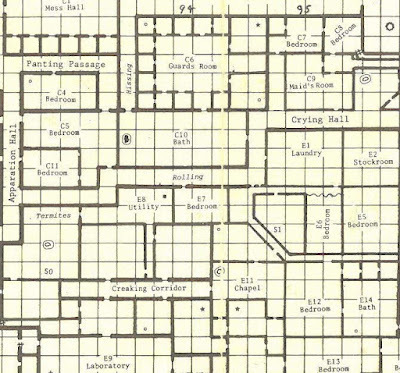Mapmaking as a Game within a Game
 When I first heard about Dungeons & Dragons, an aspect of the game that both fascinated and confused me was that it didn't have a board, unlike any other game with which I had experience up to that point. The lack of a board was something I remember reading in the many newspaper accounts of the game I saw during the late Summer and Fall of 1979. How could it be a game without a board? Furthermore, many of the media accounts of the game also talked about how the players made use of sculpted miniature figures to play. Figures? But no board? What was going on?
When I first heard about Dungeons & Dragons, an aspect of the game that both fascinated and confused me was that it didn't have a board, unlike any other game with which I had experience up to that point. The lack of a board was something I remember reading in the many newspaper accounts of the game I saw during the late Summer and Fall of 1979. How could it be a game without a board? Furthermore, many of the media accounts of the game also talked about how the players made use of sculpted miniature figures to play. Figures? But no board? What was going on? My confusion only increased after my encounter with Dungeon! over the Christmas break of that same year. Dungeon! most certainly did have a board and it certainly seemed quite similar to D&D, though it didn't make use of any sculpted figurines. In time, I made more sense of it all, thanks in part to various gaming mentors, who showed my friends and I the "right" way to play D&D, including the fact that the game's "board" was a hand-drawn map that a player drew as his party of adventurers explored a dungeon. This lesson from my elders was potent and, to this day, I continue to associate D&D strongly with maps and, more importantly, mapmaking.
Mapmaking is an aspect of D&D that, so far as I can tell, has largely disappeared or at least has been downplayed over the years. In the present moment, one might even say that it's been superseded by technology like virtual tabletops that obviate the need for graph paper and pencil. Nevertheless, maps themselves remain an important part of gameplay. Nearly every adventure, whether prepackaged or homebrewed, includes a map of its most important locales and, in many of them, exploring that map is a central feature of gaming sessions.
From my extremely anecdotal survey of the situation, I have the impression that many gamers today don't really miss the days of making their own maps. Some have even admitted that they never really enjoyed mapmaking, which they found, by turns, tedious, frustrating, and generally unpleasant. I completely understand this point of view, especially when you consider the kinds of dungeon maps that frequently appeared during the first decade of the hobby. They're filled with mazes, one-way and secret doors, teleportation traps, shifting and sliding walls, dead end corridors, and similar annoyances, all of which are specifically intended to foil or at least hinder accurate mapmaking. Where's the fun in that?
The question is more than fair in my opinion and I don't begrudge anyone who has limited or no tolerance for the vicissitudes of mapmaking – or the labyrinthine dungeons that necessitated them. At the same time, I think it's a mistake to think manual mapmaking has simply been supplanted by virtual tabletops and the like. It's increasingly my feeling that mapmaking – by hand, based on the referee's verbal descriptions – is a key activity of the game, since D&D is as much a game of exploration as it is of, say, combat. I'd also argue that it's a game with a strong element of puzzle solving and tricky dungeon maps play a big part in facilitating that element of the game.
None of this is to suggest that D&D can only be played with manual mapmaking, only that something is lost when it's not included. That's why certain races, character classes, spells, and magic items have or grant abilities that pertain to exploring the physical environment of a dungeon – finding secret doors, sloping passages, etc. It thus seems pretty clear to me that, at least as envisioned by Gary Gygax (and probably Dave Arneson as well), the play of Dungeons & Dragons revolved around, at least in part, "solving" the puzzle of a dungeon's layout, much in the same way that players did in early computer games like Wizardry or Telengard.
I don't know. I'm still trying to figure this out for myself. It may well be that manual mapmaking is simply a transitional technology that isn't nearly as integral to the way its creators intended D&D to be played as I'm suggesting here. Nevertheless, I can't shake the feeling that there's more going on than we realize and that the large scale abandonment of fumbling around with pencil and graph paper is another step on the road to a fundamental shift in the way Dungeons & Dragons is conceived and played.
Published on August 02, 2022 12:00
No comments have been added yet.
James Maliszewski's Blog
- James Maliszewski's profile
- 3 followers
James Maliszewski isn't a Goodreads Author
(yet),
but they
do have a blog,
so here are some recent posts imported from
their feed.



